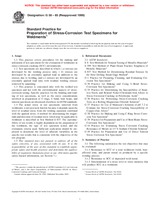We need your consent to use the individual data so that you can see information about your interests, among other things. Click "OK" to give your consent.
ASTM G58-85(1999)
Standard Practice for Preparation of Stress-Corrosion Test Specimens for Weldments
STANDARD published on 10.10.1999
The information about the standard:
Designation standards: ASTM G58-85(1999)
Note: WITHDRAWN
Publication date standards: 10.10.1999
SKU: NS-57739
The number of pages: 7
Approximate weight : 21 g (0.05 lbs)
Country: American technical standard
Category: Technical standards ASTM
Annotation of standard text ASTM G58-85(1999) :
Keywords:
Bead-on-bar weldment, Bent-beam weldment, Circular bead weldment, Corrosion-stress-corrosion, C-ring specimens, Cruciform weldment, Direct tension weldment, Flat weldment, K-welds, Pre-cracked cantilever beam test, Slit tubing weldments, Stress corrosion cracking, Tuning fork weldment, U-bend test specimens-stress corrosion cracking, Welding/welds, preparation of stress-corrosion test specimens for weldments, practice, ICS Number Code 25.160.40 (Welding joints and welds)
Additional information
| 1. Scope | ||||||||||||||||||||||||
|
1.1 This practice covers procedures for the making and utilization of test specimens for the evaluation of weldments in stress-corrosion cracking (SCC) environments. 1.2 Test specimens are described in which (a) stresses are developed by the welding process only, (b) stresses are developed by an externally applied load in addition to the stresses due to welding, and (c) stresses are developed by an externally applied load only with residual welding stresses removed by annealing. 1.3 This practice is concerned only with the welded test specimen and not with the environmental aspects of stress-corrosion testing. Specific practices for the bending and loading of test specimens, as well as the stress considerations involved in preparation of C-rings, U-bend, bent beam, and tension specimens are discussed elsewhere in ASTM standards. 1.4 The actual stress in test specimens removed from weldments is not precisely known because it depends upon the level of residual stress from the welding operation combined with the applied stress. A method for determining the magnitude and direction of residual stress which may be applicable to weldment is described in Test Method E837. The reproducibility of test results is highly dependent on the preparation of the weldment, the type of test specimen tested, and the evaluation criteria used. Sufficient replication should be employed to determine the level of inherent variability in the specific test results that is consistent with the objectives of the test program. 1.5 This standard does not purport to address all of the safety concerns, if any, associated with its use. It is the responsibility of the user of this standard to establish appropriate safety and health practices and determine the applicability of regulatory limitations prior to use. (For more specific safety hazard information, see Section 8.) |
||||||||||||||||||||||||
| 2. Referenced Documents | ||||||||||||||||||||||||
|



 Cookies
Cookies
